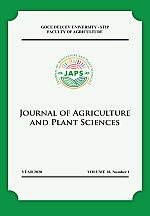SPECIFICS OF SYMBIOTIC NITROGEN FIXATION OF CHICKPEA (Cicer arietinum L.)
DOI:
https://doi.org/10.46763/JAPS2010023gAbstract
Nitrogen is a limiting nutrient for plant growth and development. The ability to use nitrogen from the air by leguminous plants is their well-known feature. Nitrogen is present in the gaseous atmosphere (N2) at about 78.1% by volume or 75.51% by weight, ie a total of 3.8x1015 t or 86.5 t / ha. However, atmospheric nitrogen, in reality, does not receive the plants directly from the air, but rather through previous adoption by Rhizobium bacteria living in the form of small tumors, called nodules on the roots of plants. These bacteria can fix nitrogen gas from the air in the soil and turn it into ammonia (NH3), which is converted into ammonium (NH4), which the plant can use.
Chickpea (Cicer arietinum L.) is a leguminous plant that has great agrotechnical significance. Characteristic of chickpeas as well as other legumes is that they enter symbiosis with nitrogen-fixing bacteria and can thus use fixed atmospheric nitrogen.
This paper presents and elaborates on the results of agrochemical analyzes of soil in the experiment with chickpea, ie differences in nitrogen content at the beginning and at the end of vegetation. The results show that the nitrogen content in the soil increased by 0.30 mg / g after the end of the vegetation in 2018 and 0.31 mg / g in 2019.
Downloads
Published
Issue
Section
License
The intellectual property and copyright on the original content of all scientific contributions in the published paper shall remain with the authors. Authors give permission to the JAPS owner to publish the paper. All authors agree to publish the paper under Attribution-NonCommercial-NoDerivatives 4.0 International license (CC BY-NC-ND 4.0).

